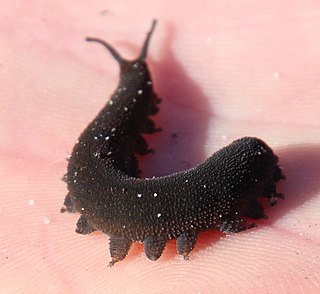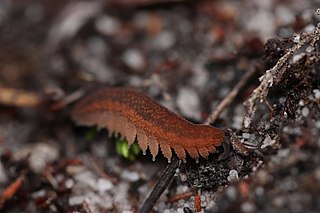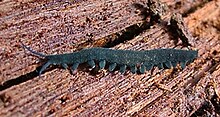Opisthopatus roseus is a species of velvet worm in the Peripatopsidae family. As traditionally defined, this species is rose pink with 18 pairs of legs. Known as the pink velvet worm, it is found only in the Weza Forest, a Mistbelt Forest in South Africa. Specimens have been found on the forest floor amongst leaf litter, beneath, and within fallen logs.
Opisthopatus is a genus of South African velvet worms in the family Peripatopsidae. The number of legs in this genus range from 16 pairs to 18 pairs. Mothers in this genus give birth to live young. In particular, this genus exhibits matrotrophic viviparity, that is, mothers in this genus retain eggs in their uteri and supply nourishment to their embryos, but without any placenta.

Peripatopsis is a genus of South African velvet worms in the Peripatopsidae family. The number of legs in this genus ranges from as few as 16 pairs to as many as 25 pairs and varies within species when the number is greater than 18 pairs. Velvet worms in this genus feature a last pair of legs that is rudimentary or reduced in size, mainly in males. This genus exhibits matrotrophic viviparity, that is, mothers in this genus retain eggs in their uteri and supply nourishment to their embryos, but without any placenta.

Occiperipatoides is a monospecific genus of velvet worm containing the single species Occiperipatoides gilesii. This genus is ovoviviparous and found in Western Australia. The genus is part of the ancient phylum Onychophora that contains soft-bodied, many-legged relatives of arthropods known commonly as velvet worms.

Ooperipatellus is a genus of Australian and New Zealand velvet worms in the Peripatopsidae family. Species in this genus are oviparous. Most species in this genus have 14 pairs of legs, but O. nanus has only 13 pairs, which is the minimum number found in the phylum Onychophora. Velvet worms in this genus are among the smallest known, with adults often only 10 to 20 millimeters long. Morphological and molecular data indicate that this genus is a monophyletic group.
Paropisthopatus is a monospecific genus of velvet worm containing the single species Paropisthopatus umbrinus. Females of this species range from 20 mm to 70 mm in length. The type locality is in central Chile. Velvet worms in this genus have 16 pairs of legs. This genus exhibits matrotrophic viviparity, that is, mothers in this genus retain eggs in their uteri and supply nourishment to their embryos, but without any placenta.
Opisthopatus cinctipes is a species of velvet worm in the Peripatopsidae family. This species has 16 pairs of legs, all with claws and all used for walking. The color of the dorsal surface varies from blue to olive green. Females range from 7 mm to 50 mm in length, whereas males range from 6 mm to 36 mm. Like other velvet worms in this genus, this species exhibits matrotrophic viviparity, that is, mothers in this genus retain eggs in their uteri and supply nourishment to their embryos, but without any placenta. The type locality is in South Africa.

Tasmanipatus barretti, the giant velvet worm, is a species of velvet worm in the Peripatopsidae family. It is the sole species in the genus Tasmanipatus and is ovoviviparous.
Opisthopatus natalensis is a species of velvet worm in the Peripatopsidae family. This species has 16 pairs of legs. The type locality is in South Africa. The validity of this species is uncertain: Although some authorities have deemed O. natalensis to be a subspecies of O. cinctipes, a similar species also found in South Africa, and others regard O. natalensis as invalid even as a subspecies, still other authorities recognize O. natalensis as a separate species, citing the significant distance between the type localities of these two species.
Cephalofovea tomahmontis is a species of velvet worm in the Peripatopsidae family. This species is ovoviviparous, has 15 pairs of oncopods (legs), and lives in rotting logs and leaf litter. The type locality is Mount Tomah, New South Wales, Australia, after which this species is named. Like all members of the genus Cephalofovea, both sexes of C. tomahmontis have a furrow on the head, between the antennae, which the male everts to carry his spermatophore to the female.
Ooperipatellus parvus is a species of velvet worm in the family Peripatopsidae. This species has 14 pairs of legs. It is found in South Australia.
Ooperipatus pulchellus is a species of velvet worm in the Peripatopsidae family. This species has 15 pairs of legs in both sexes. It is found in Victoria, Australia.
Paraperipatus lorentzi is a species of velvet worm in the Peripatopsidae family. This species is a dark green-blue. Females of this species have 22 to 28 pairs of legs; males have 21 or 22 pairs of legs. Whereas the original description of this species records 19 mm as the length of a male specimen, females range from 33 mm to 60 mm in length. The type locality is in Western New Guinea, Indonesia. The validity of this species is uncertain: Although some authorities deem P. lorentzi to be a junior synonym of P. papuensis, a similar species also found in Western New Guinea, others recognize them as two separate species.
Peripatopsis balfouri is a species of velvet worm in the Peripatopsidae family. This species has 18 pairs of clawed legs. Also known as the blue velvet worm, this species ranges from 9 mm to 22 mm in length. The type locality is in South Africa.

Peripatopsis capensis is a species of velvet worm in the Peripatopsidae family. This species has 18 pairs of legs: 17 pregenital leg pairs with claws plus one strongly reduced last pair without claws or spinous pads. Females of this species range from 9 mm to 70 mm in length, whereas males range from 6 mm to 54 mm. The native range of this species is limited to the Cape Peninsula of South Africa.

Peripatopsis lawrencei is a species of velvet worm in the Peripatopsidae family. This species has 18 pairs of legs: 17 pregenital leg pairs plus one last pair that is strongly reduced and without claws or spinous pads. This species is restricted to the Theewaterskloof-Overstrand region of South Africa.

Peripatopsis moseleyi is a species of velvet worm in the Peripatopsidae family. Males of this species have 20 to 24 pairs of legs with claws ; females have 19 to 23 pairs of legs with claws. Females range from 11 mm to 75 mm in length, whereas males range from 9 mm to 50 mm. The type locality is in South Africa.
Peripatopsis sedgwicki is a species of velvet worm in the Peripatopsidae family. Also known as the Tsitsikamma velvet worm, this species varies from blue-tan green to bright orange and brown violet. The number of legs in this species ranges from 19 pairs to 23 pairs, with a claw present on the genital pair and the last pair reduced more in the male than in the female. Females of this species range in size from 12 mm to 68 mm in length, whereas males range from 10 mm to 46 mm in length. Like other velvet worms in this genus, this species exhibits matrotrophic viviparity, that is, mothers in this genus retain eggs in their uteri and supply nourishment to their embryos, but without any placenta. The type locality is in South Africa. This species has a limited geographic distribution but is especially abundant in the indigenous forest of the Tsitsikamma mountains.
Peripatopsis storchi is a species of velvet worm in the family Peripatopsidae. This species is a clade in the P. moseleyi species complex. The number of legs in this species ranges from 21 pregenital pairs to 23 pregenital pairs. Males of this species range from 12 mm to 22 mm in length, and females range from 22 mm to 36 mm in length, but live animals can stretch to 50 mm while walking. Also known as the Katberg velvet worm, this species is known only from the Katberg forest in South Africa.
Opisthopatus herbertorum is a species of velvet worm in the Peripatopsidae family. The type locality is in South Africa. As originally described, this species is uniformly white with 17 pairs of legs. Subsequent phylogenetic results, however, cast doubt on this species delimitation based on morphology, indicating instead that O. herbertorum is a junior synonym of O. roseus.








